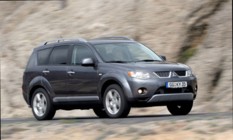Review

By this time next year, some car firms will have suffered some very nasty SUV-based injuries.
The sheer number of models being launched in the next few months means there is no way they can all succeed – there just isn’t the business out there. The question is: will the Outlander be one of the vanquished?
On the face of it, Mitsubishi should be in a decent position with its long history of four-wheel drive vehicles. The likes of Peugeot, Citroën and Vauxhall may have a tougher fight.
And that specialism might be important too, because behind the metal the Outlander shares much of its underpinnings with the upcoming Peugeot 4007 and Citroën C-Crosser. In total 10 new models will use this chassis architecture, jointly developed with DaimlerChrysler. The engine is even borrowed from Volkswagen.
So it stands a better chance than the last Outlander which was an unmitigated failure, hamstrung by its petrol-only power and its ‘uniqueness’.
The new model has all the basics of a good SUV. It looks very chunky, has a quality diesel engine, a seven-seat option and is competitively priced.
The front styling is a success and it certainly made a few people look twice. The rear is less successful, being a little too fussy with its LED tail lights.
In Warrior spec, there is all the usual blacked-out windows and metallic bling that Mitsubishi fits to its cars but overall it’s a handsome package
On the inside, there’s the usual amount of cheap-looking plastic that Mitsubishi seems so keen on, but the dash is cleanly laid out and there’s also plenty of space.
The seven-seat ‘Hide&Seat’ system is standard on Warrior specification and above and really can’t be used for much more than transporting children or drunk people not fussed about comfort. But then what else are the sixth and seventh used for? They snap out of the floor with the pull of a couple of straps, and fold away with similar alacrity.
And should you want a completely flat load bay, the second row of seats fold down electrically at the push of a button, which is very handy indeed. A split tailgate adds to the all-round usefulness.
On start-up the 138bhp 2.0-litre diesel engine, also in the likes of Passat and Golf, is as noisy as it has ever been in a car. It is exceptionally boomy, but as it warms up it becomes a lot more acceptable and does all of the things usually expected of it. It’s not fast off the mark, but gives the Outlander decent in-gear acceleration, while returning around 40mpg.
In almost all conditions, the Outlander will live in two-wheel drive, although it can be switched into four-wheel drive at the turn of a dial. It handles well too – not too wallowy, but not too stiff either – while the gearbox is a joy.
In a very competitive market, the Outlander has all the attributes for a good year.

Fact file
P11D value: £21,202
CO2 emissions (g/km): 173
BIK % of P11D in 2007: 24%
Graduated VED rate: £165
Insurance group: 11
Combined mpg: 43.5
CAP RV (3yr/60k): £8,550/39%
Monthly lease (3yr/60k): £365
Positive:
Negative:
THREE RIVALS TO CONSIDER
P11D PRICE
Considering these cars all cost more than £20,000 they aren’t overly equipped. The Outlander is the best with cruise and climate control, seven seats and 18-inch alloys. The Freelander is the spartan entry model, while the Santa Fe has seven seats and the CR-V parking sensors.
Freelander: £20,705
CR-V: £21,202
Santa Fe: £21,787
Outlander: £21,801
EMISSIONS AND TAX RATES
The CR-V is comfortably the lowest on emissions but none of these cars is especially filthy and a driver choosing any should feel suitably guilt-free. The CR-V is best in BIK tax, costing a 40% taxpayer just over £2,000 a year – more than £200 better than the Outlander.
CR-V: 173g/km/24%
Outlander: 183g/km/26%
Santa Fe: 193g/km/28%
Freelander: 194g/km/28%
SMR COST
Service intervals every 9,000 miles make the Mitsubishi the most expensive for SMR – strange when it runs a Volkswagen engine. The Santa Fe has to make the trip every 10,000 miles while the Freelander and CR-V can go longer at 15,000 and 12,500 miles respectively.
CR-V: 4.00 (pence per mile) £2,400 (60,000 mile total)
Freelander: 4.22 £2,532
Santa Fe: 5.01 £3,006
Outlander: 5.13 £3,078
FUEL COST
The CR-V is the most fuel efficient: its sub-£6,000 bill equates to a 43.5mpg average, helped by the drivetrain which only switches to four-wheel drive when needed. The Freelander is the most thirsty but its 37.7mpg average is more than respectable.
CR-V: 9.89 (pencer per mile) £5,934 (60,000 mile total)
Outlander: 10.75 £6,450
Santa Fe: 11.12 £6,672
Freelander: 11.41 £6,846
DEPRECIATION COST
Both Honda and Land Rover’s previous CR-V and Freelander performed well in the used market and much the same is expected of the current models after three years/60,000 miles. The other two don’t have the brand or the years of success behind them yet.
Freelander: 18.63 (pence per mile) £11,178 (60,000 mile total)
CR-V: 18.87 £11,322
Outlander: 22.08 £13,248
Santa Fe: 23.02 £13,812
WHOLELIFE COST
The CR-V scores a comprehensive victory, winning all sections apart from depreciation.
The Outlander performs decently without starring in any particular section, while the Santa Fe looks expensive for a Hyundai competing against these three more prestigious brands.
CR-V: 32.76 (pence per mile) £19,656 (60,000 mile total)
Freelander: 34.26 £20,556
Outlander: 39.00 £23,400
Santa Fe: 39.15 £23,490
VERDICT
Although the Freelander comes close to the CR-V it is the entry-level model and a driver will notice the sparse level of equipment. The Hyundai is a good car but is well off the pace in running costs terms, as is the Outlander – although it would be a perfectly good choice, especially if somebody needs seven seats. But the CR-V just does everything a driver of an SUV would want: low fuel costs, stylish looks, dependability and space.















Login to comment
Comments
No comments have been made yet.